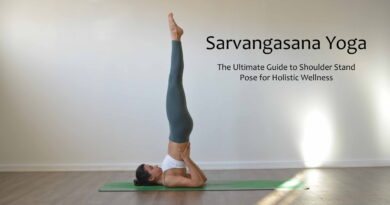Prasarita Padottanasana Yoga: Unleashing Strength and Flexibility with Wide-Legged Forward Bend
Table of Contents
Introduction
Prasarita Padottanasana Yoga, commonly known as Wide-Legged Forward Bend, is a dynamic and invigorating yoga pose that offers a multitude of physical and mental benefits. Derived from the Sanskrit words “prasarita” (meaning spread out), “pada” (meaning foot), and “uttana” (meaning intense stretch), this pose involves a wide-legged stance and a deep forward fold, promoting strength, flexibility, and a sense of groundedness.
In this article, we will explore the steps, benefits, variations, and precautions associated with Prasarita Padottanasana, empowering you to incorporate this transformative pose into your yoga practice.
How to Perform Prasarita Padottanasana Yoga
To practice Prasarita Padottanasana Yoga, follow these step-by-step instructions:
Step 1: Begin by standing at the front of your yoga mat with your feet parallel and wider than hip-width apart.
Step 2: Ensure that your outer edges of the feet are parallel to the edges of the mat.
Step 3: Engage your leg muscles and maintain a strong and tall spine.
Step 4: On an exhale, start to hinge forward at your hips, leading with your chest.
Step 5: Place your hands on the mat in front of you, shoulder-width apart, and between your legs.
Step 6: Maintain the length in your spine as you continue to fold forward, aiming to bring the crown of your head toward the mat.
Step 7: Keep your weight evenly distributed between your feet, grounding through all four corners of each foot.
Step 8: Relax your neck and let your head hang freely.
Step 9: Breathe deeply and hold the pose for 30 seconds to a minute, gradually increasing the duration as you progress in your practice.
Step 10: To release the pose, engage your core, press into your feet, and slowly come up to a standing position.
Benefits of Prasarita Padottanasana Yoga
Regular practice of Prasarita Padottanasana Yoga can bring numerous benefits to your physical and mental well-being, including:
a. Deep Stretching: The wide-legged stance and forward fold in this pose provide a deep stretch to the hamstrings, inner thighs, groin, and hips, promoting increased flexibility and suppleness in these areas.
b. Strengthened Legs and Core: Holding the wide-legged position engages and strengthens the muscles of the legs, including the quadriceps and inner thigh muscles. It also activates the core muscles, contributing to improved stability and balance.
c. Improved Posture and Spinal Health: Prasarita Padottanasana Yoga encourages a straight and elongated spine, helping to correct posture and alleviate tension in the neck and back.
d. Enhanced Blood Circulation: The inversion nature of this pose facilitates blood flow to the upper body and brain, providing a refreshing boost of energy and nourishment.
e. Relieved Mental Stress and Anxiety: The forward fold in Prasarita Padottanasana Yoga calms the mind, releases tension, and promotes a sense of relaxation, helping to reduce stress and anxiety.
f. Increased Focus and Concentration: The combination of the pose’s physical intensity and deep breathing encourages a heightened state of focus and concentration, enhancing mental clarity and awareness.

Variations of Prasarita Padottanasana Yoga
Here are a few variations of Prasarita Padottanasana Yoga that you can explore:
a. Parsvottanasana (Pyramid Pose): From the wide-legged stance, turn one foot out at a 90-degree angle and fold forward, placing your hands on the mat or a block on either side of your front foot. This variation provides an additional stretch to the hamstrings and calves while targeting the hips and shoulders.
b. Prasarita Padottanasana C (Triangular Arm Balance): From the wide-legged position, place your hands on the mat shoulder-width apart, and lift one leg off the ground, extending it straight back. Maintain balance and stability as you hold the pose, engaging the core and strengthening the arms.
c. Prasarita Padottanasana with a Twist: While in the forward fold, place one hand on the mat or a block and reach the other hand toward the ceiling, twisting your torso. This variation adds a spinal twist, enhancing the stretch in the torso and promoting spinal mobility.
Precautions and Contraindications
While Prasarita Padottanasana Yoga is generally safe for most practitioners, it’s important to consider the following precautions:
a. Individuals with low back injuries or conditions should approach this pose with caution or seek guidance from a healthcare professional or an experienced yoga instructor.
b. If you have high blood pressure or vertigo, avoid folding too deeply forward and keep your gaze forward or slightly downward to avoid dizziness.
c. If you experience any pain or discomfort in the knees, hips, or lower back, modify the pose by bending the knees slightly or reducing the depth of the forward fold.
Conclusion
Prasarita Padottanasana Yoga, the Wide-Legged Forward Bend, invites you to expand your physical and mental horizons, fostering strength, flexibility, and inner balance. By incorporating this powerful posture into your regular yoga practice, you can experience improved flexibility, strengthened legs and core, and a sense of calm and grounding.
Embrace the transformative potential of Prasarita Padottanasana Yoga, honoring your body’s abilities, and exploring the depths of this pose to unlock its profound benefits. Step onto your mat, spread your wings wide, and dive into the enriching practice of Prasarita Padottanasana Yoga.





